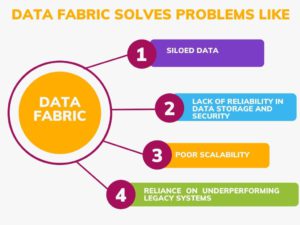What is a Data Fabric and What is Its Business Value
What is the business value of a data fabric solution? There’s a new buzzword in the world of data analytics, and that is – data fabric. The word, which denotes a definitive environment comprising a united ecosystem consisting of all the technologies involved in data analytics, has caught on this year.
Table Of Contents
- What is Data Fabric?
- Why does a Business Need Data Fabric
- How does Data Architecture Work With Data Fabric
- How can Data Fabric be of Help
- What Business Value can be Derived from Data Fabric?
What is Data Fabric?
A data fabric is a setup that enables the organization to better use the data that it has. A data fabric facilitates self-service data consumption, embeds governance, and automates the data integration process. This way the organization can optimize the data for faster insights. It also helps reduce data inconsistency and compliance risk and improves data quality.
Data Fabric also can help businesses:
- Reduce costs by utilizing the best and most accurate source of data
- Reduce risk by automating data quality processes
- Accelerate insight delivery with a single view of all relevant information across your enterprise
Our experts are on standby if you want to know more about data fabric and how it can help. Speak to Our Experts, they will help you.
The term data fabric refers to the “physical topology of servers and other hardware components used to store and process data.” The idea is that you should be able to move data around between different components like physical servers, virtual machines containers, and storage accounts. This is an idea that has been around for a while now, and it’s still considered cutting edge.
Data fabric provides a way for various types of data (e.g. schema, context, history, etc.) to be passed around the applications that use them. A single instance of any one type of data can exist in multiple places, but it is important that each instance points to the same physical resources and that the data types are the same.
Data can be moved from one component to another as needed.
Data fabric is also used to reduce the amount of management required, and to provide a single point of control for managing resources and settings across multiple physical and virtual resources.
According to one article, Data Fabric provides a catalog of consistent data services across private and public clouds. This explanation says enterprises have grappled with the problem of the integration of their entire data sets into a single platform. A data fabric simply describes a comprehensive way to make that goal.
Try and imagine a large piece of hypothetical fabric extended over a theoretical space that joins multiple data points across locations, including the cloud, all kinds of structured and unstructured data, along with methods for accessing that data and analyzing it. Unlike a piece of cloth, a data fabric does not have a fixed shape, is scalable, and has in-built fluidity that accounts for data processing, management, and storage. It can be accessed or shared by internal and external teams for a wide variety of enterprise analytical and operation use cases.
Are you ready for your business transformation?
What Data Fabric is not:
- A fancy word that describes the same old processes or solutions
- A one-time resolution of a data problem
We must understand that as data analytics gets cost-effective and more democratic, and as the world marches towards becoming a data-centric one, the entire operation needs to get more cohesive and easy to use.
That’s where the scalable data fabric comes in for it not only helps to manage the collection, governance, integration, and sharing of data but also to solve challenges along the way. And, it prevents data from accumulating in silos.
Why is Data Fabric Required?
The goals are simple enough – to provide a single environment for accessing data, and to enable simpler and unified data management. But the overarching aim is to maximize the value of your data.
Let’s first examine the hurdles before an enterprise that is on its way to digital transformation:
- Data in multiple on-premise and off-premise locations
- Data cleansing issues
- Structured and unstructured data
- Data in a variety of formats
- Use of different technologies and multiple data integration tools
- Lack of scalability

All of the above uses about 70-80% of a data professional’s time for doing non-essential tasks. Clearly, it is in the interest of an enterprise to strive towards a single environment for accessing, collecting, and analyzing all data.
That’s what a data fabric does – making the enterprise extremely agile.
How does Data Architecture Work with Data Fabric?
With a data fabric, you can map data from disparate apps (including data stored in different places) so that they are ready for business analysis.
Insights and decisions can be drawn from existing and new data points with connected data.
As opposed to static reports or dashboards, this is a very dynamic experience.
Data architecture is an important consideration in the design of your data fabric. Data architecture is at the top of the data life cycle and encompasses many architectural considerations.
A data architecture architect can guide the design of your data fabric, and help determine the type of system you should use.
A data architecture describes how you model your data. You can map each data object as a member of a table, as a property of a database, or as an element of a service.
The goal is to optimize the structure of your data for all aspects of its lifecycle, including growth, security, performance, reliability, and functionality.
Typically, an architect starts with a business data model, which describes how all the relevant business entities are modeled as data tables.
Using this approach, you can then manage your data independently of the systems that contain it. This is the foundation of the Data Fabric design model.
The basic structure of data fabric is a set of discrete data centers, often using NSX or SDN technologies, that communicate with each other over secured virtual links.
Each data center is the equivalent of a traditional server and represents a point of entry for data. Each data center can hold several data volumes and supports both local and distributed database workloads.
A data fabric solves several problems like:
- Siloed data
- Lack of reliability in data storage and security
- Poor scalability
- Reliance on underperforming legacy systems
How does a Data Fabric Help?
Here are the many ways:
- It helps with data inputs and integration abilities between data sources and apps
- Helps with bolstering data quality, data preparation, and data governance capabilities
- It helps connect with any data source via pre-packaged modules and does not require any coding
- It helps handle multiple environments such as cloud, on-premise, and hybrid
What Business Value can be Derived from Data Fabric?
Data fabric is the most important thing in modern IT infrastructure. It can be used for two types of business value: data governance and application integration. Both are independent but work together.
The data fabric builds the foundation for modern applications by architecting the right foundation that supports the management of information assets throughout their lifecycle.
Data governance refers to the ability to track and govern data across environments, applications, and users.
For example, when objects are moved from one environment to another, the data fabric will notify all the components that the object has been moved and take care of processing accordingly (what processes to run, how they should be run, and what the state of the object should be).
Dynamic data fabrics are built on contextual information. Data fabric should be able to identify, connect, and analyze technical, business, operational, and social metadata (in the form of a well-connected pool of metadata).
The data fabric will provide actionable insights that will enable real-time decision-making by business users.
The fabrics are getting smarter with each passing day, and are redefining the essence of dynamic architecture to cater to the needs of the evolving digital world.
Data governance is of primary importance in the evolution of the data fabric and its ability to continuously improve and deliver real-time insights.
Data governance and architecture design and development and integration of the same will provide more strategic and tangible business benefits and be more flexible and agile for organizations.
Enterprises must activate metadata to ensure frictionless data sharing. In order to achieve this, the fabric should:
- Create a graph model by constantly analyzing metadata for key metrics and statistics
- Show the relationships between metadata in graphical form in a way that is easy to understand
Furthermore, it can improve business-level metadata governance, increase collaboration, and allow companies to speed time-to-value by facilitating 360-degree customer views, fraud detection, and deleting data in silos, among other features. What’s more, by exploiting metadata metrics, AI/ML algorithms can learn over time and provide advanced predictions regarding the integration and the management of data.
Are you ready for your business transformation?
In conclusion: A single instance of any one type of data can exist in multiple places, but it is important that each instance points to the same resources, and that the data types are the same.
Data can be moved from one component to another as needed. A data fabric is used to reduce the amount of data management required, and to provide a single point of control for managing resources and settings across multiple physical and virtual resources.


No comments yet.